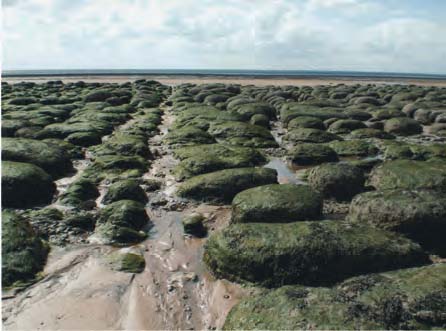Issue
18
Page
9
It felt like a trip that was destined not to happen. John Llewellyn-Jones and Celia Pain had carried out a preliminary survey of the Hunstanton shore and originally planned the trip but in the end both had to drop out of the actual visit due to illness. Jan Light then stepped into the breach to lead but slipped a few days before and broke her wrist. Finally, following what had been an absolutely glorious Friday the forecast for Saturday was rain and sure enough at around half past twelve (we were due to meet at 1:00) the clouds opened in what can only be described as tropical monsoon style. Still, we had come this far and a little water wasn’t going to stop proceedings now.
The remaining party of seven intrepid explorers assembled, donned waterproofs and boots and headed down onto the shore. It is normally a popular beach with holiday makers at this time of the year but as we arrived it was more or less deserted having been very effectively cleared out by the rain.
We concentrated our initial search on the lower shore Mytilus beds. The most striking feature of these was the high abundance of our first nonnative of the day – the slipper limpet, Crepidula fornicata. Also notable though was the colour of the Nucella lapillus shells which ranged from light yellow to orange – a colour I certainly had never seen before. As we slowly followed the tide out and up the second live non-native – a couple of live specimens of Crassostrea gigas. The Mytilus bed gradually gave way to a more muddy, less consolidated, habitat and the starfish Asterias rubens was relatively common. We also picked up a few Lepidochitona cinereus particularly under larger dead shells. On the way back up the shore we met a bait digger who was having no difficulty digging up live Ensis americanus. While pairs of Venerupis senegalensis shells were plentiful we didn’t pick up any live specimens of this species.
There was very little algae on the shore and the few fragments we did find did not look promising from a molluscan perspective. This view was borne out when the samples were later analysed with only Mytilus spat being recorded.
After a short stop we headed back up the beach to explore an area of upper to mid shore bounders embedded in sand just in front of the lighthouse. These still failed to yield more ubiquitous species such as Patella vulgata. However we did pick up a small boulder of peat that contained live Barnea candida and Petricola pholadiformis which was quite a nice find to finish off the day.
By the time we made our way back towards the car park the sun had come out again and the beach was beginning to fill up with bemused onlookers, attired in nothing more than shorts, wondering what on earth we were doing dressed in waders, waterproofs and scarves on such a beautiful day!
The status of Ensis remains interesting. Howlett (1990) recorded that while the abundance of Ensis americanus had increased (for Old Hunstanton he recorded “20 broken shells” along the strand), Ensis arcuatus had disappeared from the area and Ensis siliqua was a rarity. Paul Dansey who worked these shores over ten years in late 1990s also recorded E. americanus as the predominant species but in much higher densities. Dansey also recorded Ensis minor (rather than E. siliqua recorded by Howlett) with a ratio of about 1 specimen to every 100 of E. americanus. Dansey also noted that Ensis arcuatus was still present but very rare (Dansey pers. Comm.). The latest trip verifies Dansey’s observations that E. americanus is by far the most dominant species of Ensisin the area – the sheer abundance of the valves makes it difficult to spot other species. The reason E. americanushas become so dominant in unclear but may be related to the species being less affected than our native species by the silty conditions in the area. However, at present there is not really any evidence to support it actually out-competing our native species completely.
Reference
Howlett, D.J., (1990). The arrival in Britain of Ensis americanus (Binney). Conchologists Newsletter 114 (301-302)
The full species list is:
Lepidochitona cinerea LO
Gibbula cineraria LO
Littorina littorea LF
Littorina saxatilis LF
Ocenebra erinacea SR
Nucella lapillus LF
Buccinum undatum LR
Polinices polianus SR
Crassostrea gigas LR
Lucinoma borealis SO
Mysella bidentata LR
Ensis minor SR
Scrobicularia plana SR
Dosinia lupinus SR
Mya truncata SO
Mya arenaria SR
Barnea candida LO
L = live, S = shell, R = rare, O = occasional, F = frequent, C = common, A = abundant
Photographs

Fig 1: The Hunstanton shore, upper-mid shore boulder field (June Chatfield)

Fig 2: Crepidula fornicata (June Chatfield)

Fig 3: Ensis americanus on the strand line (June Chatfield)
